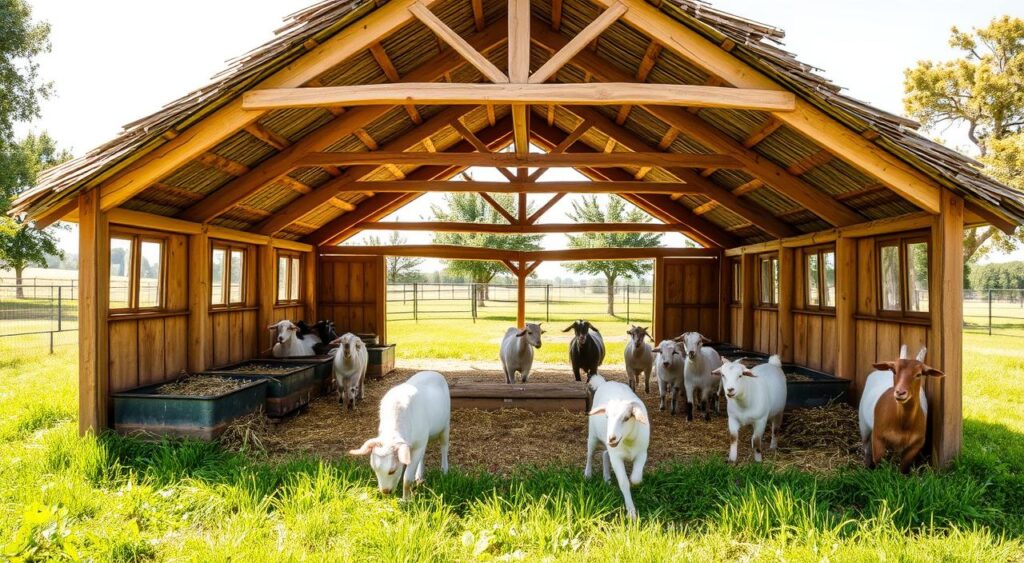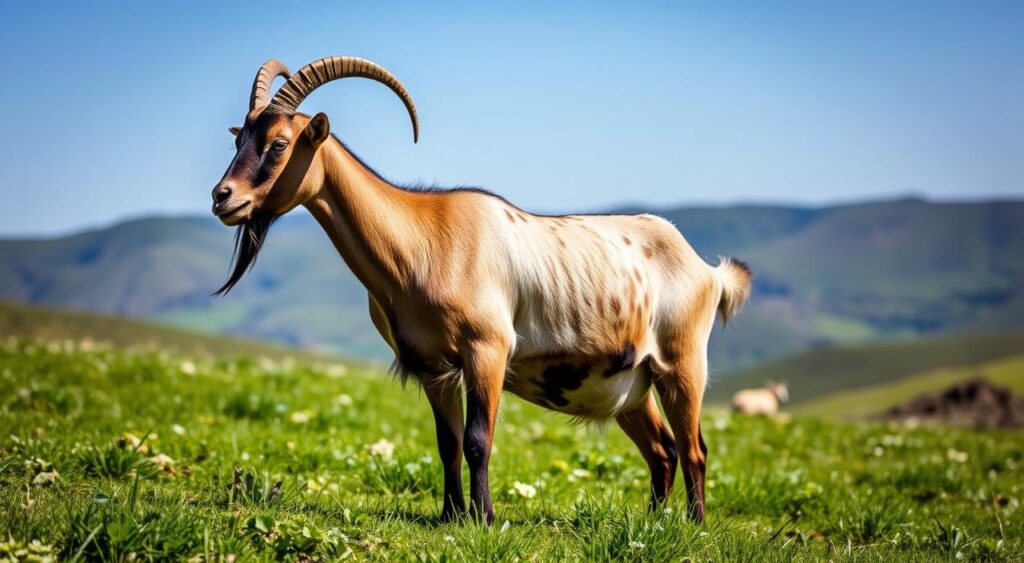The Barbari goat is a special and tough breed from northwest India’s dry lands. It’s known for being adaptable, breeding a lot, and being good for both milk and meat. This goat is key to preserving biodiversity and needs more protection. This article will cover the Barbari goat’s basics, like where it comes from, what it looks like, and how to care for it.
We’ll talk about its origins, looks, stats, breeding, milk and meat making, health problems, and how to keep it happy. We’ll also look at its role in farming that’s good for the planet.
Key Points
- The Barbari goat is a hardy, dual-purpose breed native to the dry regions of northwest India.
- Barbari goats are known for their adaptability, prolific breeding, and ability to produce both milk and meat.
- The Barbari goat population is estimated to be around 30,000 purebred animals, making it a rare and threatened breed.
- Barbari goats have an average lactation yield of 107 liters over a 150-day period.
- Common health issues in Barbari goats include coccidiosis, enterotoxaemia, and foot rot, which can be managed with appropriate treatments.
Introduction to the Barbari Goat Breed
The Barbari goat comes from Rajasthan, Etah, Agra, and Aligarh districts in India. It’s known for being small and tough. These goats are great at handling the local weather.
They are important for the local farmers. They give meat, milk, and help farmers make money.
Origins and Distribution
In 1972, there were about 0.444 million goats in the Barbari area. This included 0.028 million adult males and 0.270 million adult females. They live between the Ganga and Yamuna rivers. Places like Mathura, Aligarh, and Kashganj District are their home.
Distinctive Physical Characteristics
The Barbari goat is small and sturdy. It has big eyes because of a special bone. They come in many colors, but white with brown patches is common.
Both males and females have twisted horns. These horns are medium length and point up and back. They weigh 30-35 kg for females and 40 kg for males.
They are well-suited to the local weather. They do best in temperatures around 20°C and 69% humidity.
Breed Characteristics and Statistics
The Barbari goat is a popular breed in India, known for its high-quality milk and meat. Adult males weigh about 37.85 kg, while females weigh around 22.56 kg. They are small, with males reaching 70.67 cm and females 56.18 cm at the withers.
Their coats come in various colors, but white with light brown patches is the most common. This makes them stand out.
Flock Structure and Management
A typical Barbari goat flock has 9.25 goats. This includes 0.6 adult males, 5.3 adult females, and 3.4 young ones. These goats eat a mix of plants, grains, and cultivated foods.
Many male kids are castrated and raised for festivals. This practice is common in their management.
Body Measurements and Conformation
The Barbari goat has a well-built body with a broad chest and strong frame. Genetic studies show they have a lot of genetic variation. This makes them great for improving through breeding.
They are also very adaptable to India’s varied climate. Their hardiness is a big plus.
| Trait | Males | Females |
|---|---|---|
| Average Body Weight (kg) | 37.85 | 22.56 |
| Average Height at Withers (cm) | 70.67 | 56.18 |
| Average Flock Size (individuals) | 9.25 | |
| Adult Males | 0.6 | |
| Adult Females | 5.3 | |
| Young | 3.4 | |
Reproductive Traits of Barbari Goats
The Barbari goat is known for its great reproductive abilities. These goats are ready to have their first kids at about 1.77 years old. They have kids every 348 days, showing how fertile they are.
Litter Size and Kidding Percentage
Barbari goats are very good at having kids. About 70.2% of them have kids. Most have one kid, but 49.32% have twins. A small number, 1.04%, have triplets.
The death rate for kids before they can wean is very low, at 0.87%. The death rate for adult goats is even lower, at 0.19%. This shows how strong and adaptable the breed is.
These traits make Barbari goats very valuable for farmers and small producers. Knowing how the breed reproduces helps breeders improve their work. This can make their farms more productive and profitable.
Barbari Goat Milk Production

The Barbari goat is famous for its high milk production. It can produce an average of 107.12 kg of milk over 150.13 days. This breed is loved for its quality milk and is great for dairy farming.
Its milk is rich and perfect for making butter, cheese, and more. These products are traditional favorites.
Lactation Yield and Length
Barbari goats produce a lot of milk. On average, a doe gives 0.4 liters of milk daily. This adds up to 107.12 kg over 150.13 days.
Because of their size and gentle nature, Barbari goats are perfect for small farms. They are common in India and Pakistan.
The milk from Barbari goats is in high demand. It’s great for making many dairy products. This boosts the economy of barbari goat dairy farming and helps rural communities.
Meat Production Potentia
Beyond their impressive dairy capabilities, Barbari goats are renowned for their exceptional meat production. These hardy, indigenous goats exhibit rapid growth rates and favorable carcass conformation. This makes them a valuable asset for small-scale and subsistence-level farming operations. Where the demand for high-quality, locally-sourced meat is in high demand.

Weight Gains at Different Growth Stages
At birth, Barbari kids weigh an average of 1.739 kg, showing their strong start. By weaning, these kids have gained substantial weight, reaching 6.661 kg. Their impressive growth continues, with Barbari goats reaching 7.8 kg at 6 months, 12.566 kg at 9 months, and an impressive 14.517 kg by 12 months.
| Growth Stage | Average Weight (kg) |
|---|---|
| Birth | 1.739 |
| Weaning | 6.661 |
| 6 Months | 7.8 |
| 9 Months | 12.566 |
| 12 Months | 14.517 |
This rapid growth rate, coupled with the Barbari’s favorable meat conformation, make this indigenous breed a highly sought-after choice. For small-scale and subsistence-level goat farming operations seeking to meet the growing demand for high-quality, locally-sourced barbari goat meat production.
Health Issues and Disease Management
Barbari goats face many health problems that need careful handling. These include coccidiosis, enterotoxaemia, acidosis, and more. They also get diseases like Johne’s, tetanus, and pneumonia.
To keep barbari goat health in check, a detailed plan is key. This plan includes goat disease management, goat parasite control, and goat vaccination programs. Regular vet visits and treatments are vital to stop these diseases.
Common Diseases and Treatments
Here are some common barbari goat diseases and how to manage them:

- Coccidiosis: Treated with antiprotozoal meds and clean living spaces.
- Enterotoxaemia: Prevented with shots and the right diet.
- Pneumonia: Treated with antibiotics and care to help them breathe.
- Foot Rot: Fixed with foot baths and better hoof care.
- Parasitic Infections: Kept under control with deworming and clean pastures.
Keeping goat housing, nutrition, and herd health top-notch is key. Regular vet visits help manage barbari goat diseases. This ensures the health and happiness of Barbari goats for years to come.
Housing and Feeding Requirements
Barbari goats are a favorite in small ruminant farming. They need special housing and food to stay healthy and productive. These goats do well in small spaces, needing about 10 square feet each.
They prefer raised, well-ventilated homes that are easy to clean. This keeps them healthy and comfortable.
For food, Barbari goats love grass hay and goat-specific grains. They also enjoy fresh veggies and minerals. It’s important to give them clean water and salt blocks too. This ensures they get all the nutrients they need.
By meeting these housing and feeding needs, farmers can keep their Barbari goats happy and productive. This helps their farming business thrive.
| Goat Breed | Dry Matter Intake (g/kg metabolic body weight) | Milk Yield (liters per lactation) |
|---|---|---|
| Non-descript | 70 | 60 |
| Barbari | 75 | 100 |
| Jamunapari | 65 | 250 |
By giving Barbari goats the right home and food, farmers can boost their growth and milk production. This helps small ruminant farming succeed.
Barbari Goat for Sustainable Farming
The Barbari goat is perfect for small-scale farming. It’s small, tough, and useful for many things. These goats do well with little food and can handle tough places.

They are also very fertile and don’t need much food. This makes them great for farmers who want to keep their land productive. They help farmers keep their barbari goat sustainability, barbari goat benefits, and barbari goat small farm operations.
Benefits of Raising Barbari Goats
Keeping Barbari goats helps keep biodiversity alive. It also helps small farmers make a living. These goats are good for the environment and for farmers.
By choosing Barbari goats, farmers can make their farms better. They can make more money and help keep India’s farming traditions alive.
| Key Benefits of Raising Barbari Goats | Details |
|---|---|
| Compact Size and Hardy Constitution | Barbari goats thrive on limited resources and can navigate challenging terrains, making them well-suited for small-scale farms. |
| Dual-Purpose Utility | Barbari goats are valued for both their milk and meat production, providing a versatile source of income for farmers. |
| High Fertility and Adaptability | Barbari goats have high fertility rates and can adapt to diverse environmental conditions, contributing to their sustainability. |
| Disease Resistance | Barbari goats demonstrate resistance to common goat diseases and parasites, reducing the need for costly treatments. |
| Maintenance of Biodiversity | Preserving and promoting the Barbari breed helps conserve India’s rich agricultural heritage and barbari goat biodiversity. |
By choosing Barbari goats, farmers can make their farms better. They can make more money and help keep India’s farming traditions alive.
Conservation Efforts for the Breed
The Barbari goat is a rare breed that is very useful. It has a small population, with only about 30,000 animals left. This is a big problem because people are choosing bigger goats instead.

To save the Barbari goat, we need to act fast. We must start breed registries, plan breeding carefully, and tell people about the Barbari. This will help keep the Barbari goat alive and support rural communities.
Government and research groups are working hard to save the Barbari goat. They are doing many things to help:
- They are setting up breed registries to keep track of the goats.
- They are planning breeding to keep the Barbari’s special traits.
- They are teaching people about the importance of the Barbari in farming.
- They are working with local people to learn and use traditional knowledge.
- They are joining efforts to protect other indigenous livestock too.
These efforts are trying to save the Barbari goat. They want to keep its special traits alive. This is important for the future of farming and for the people who depend on it.
Breeding and Selection Strategies
To protect the Barbari goat breed, it’s key to have good breeding and selection plans. Breeders need to pick and breed goats with traits like high milk, fast growth, and strong health. They should also look for goats that do well in local weather.

Improving Productivity and Hardiness
Keeping records, testing performance, and checking genetics helps find the best breeding goats. This way, breeders can make the Barbari goat better at producing milk, growing fast, and handling tough weather.
Working together, farmers, researchers, and officials can create better breeding plans. This team effort keeps the breed’s unique traits while making it more valuable and adaptable to the environment.
| Trait | Improvement Strategy |
|---|---|
| Milk Yield | Identify and breed high-yielding Barbari does, maintain detailed lactation records |
| Growth Rate | Selective breeding for rapid weight gain, monitor growth performance |
| Disease Resistance | Evaluate Barbari goats for disease resilience, prioritize breeding of hardy individuals |
| Adaptability | Select Barbari goats that thrive in local environments, assess tolerance to heat, drought, and other stressors |
Through smart breeding and selection, Barbari goat breeders can make the breed better. This ensures the breed’s future and its role in sustainable farming.
Marketing and Business Opportunity
The Barbari goat is a unique and adaptable breed. It offers promising business opportunities for small-scale farmers and entrepreneurs. Its impressive milk and meat production makes it popular for commercial goat farming.
Developing effective marketing strategies is key. Targeting local and regional markets for Barbari goat products can increase visibility and income. Exploring value-added processing and product diversification can also boost profitability.
Building cooperative networks among farmers is valuable. By working together, farmers can market products better, negotiate prices, and access more channels. This collaboration can strengthen the Barbari goat business and open new growth opportunities.
Using the Barbari goat’s quality and cultural significance can lead to new opportunities. Farm visits, educational tours, and culinary experiences focused on Barbari goat products can attract consumers. This diversifies the goat farming enterprise.
As demand for goat product commercialization grows, the Barbari goat’s unique traits are promising. They offer a path for small ruminant value chains and sustainable income for small-scale farmers and entrepreneurs.
Conclusion
The Barbari goat is a remarkable breed that needs more attention and protection. It’s small, tough, and good for both milk and meat. This makes it perfect for small farms in India.
By learning about the Barbari goat’s special traits and needs, farmers can make the most of it. This helps in improving rural life, ensuring food, and keeping farm diversity alive.
It’s important to work together to save the Barbari goat. We need to focus on breeding, marketing, and conservation. This will help it stay relevant in farming.
India has the most goats in the world and is a big producer of goat products. Saving breeds like the Barbari goat is key for India’s farm diversity. It also helps small farmers.
We should value the Barbari goat and use good conservation plans. This way, it can keep helping farming and rural communities in India. Its hardiness and usefulness are big benefits for farming and fairness.




